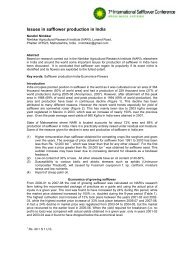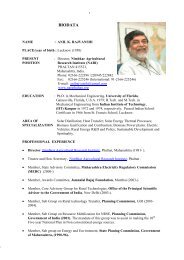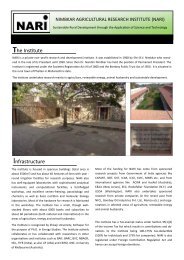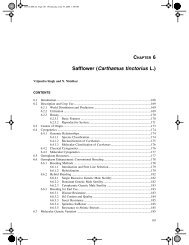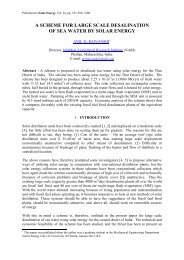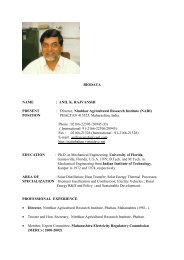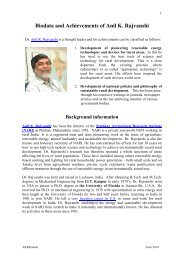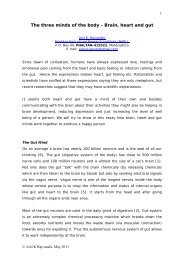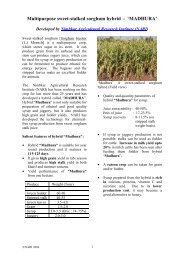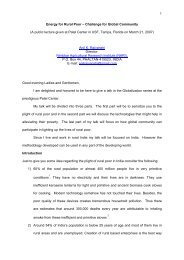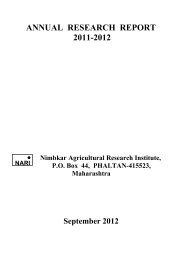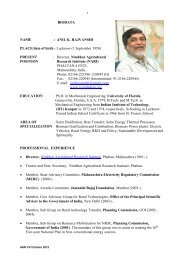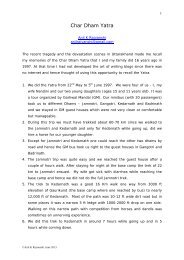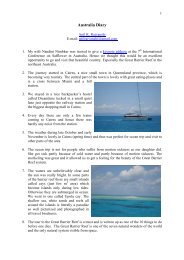weather data including solar radiation - NARI
weather data including solar radiation - NARI
weather data including solar radiation - NARI
You also want an ePaper? Increase the reach of your titles
YUMPU automatically turns print PDFs into web optimized ePapers that Google loves.
Long term <strong>weather</strong> trends in western MaharashtraA. Jacob 1 and A. K. Rajvanshi 2,11French intern at <strong>NARI</strong>, student from Ecole Centrale de Lyon, Ecully 69130, France.2Director <strong>NARI</strong>, Nimbkar Agricultural Research Institute (<strong>NARI</strong>), Phaltan 415523,India.AbstractThis study aims at analysing the meteorological <strong>data</strong> collected by NimbkarAgricultural Research Institute (<strong>NARI</strong>) since 1983. The main objectives were toprovide average figures and curves of Phaltan <strong>weather</strong>, and to identify possibletrends since 1983, especially warming. Results show that there is indeed a clearwarming trend, but it seems to be influenced by changes in the surroundings of thestation (microclimate). Wind velocity and evaporation have also slightly decreased.Increase in plant cover in Phaltan area might have played a role.Keywords: climate change, rainfall trend, temperature trend, <strong>weather</strong> composites,rural areaKnowledge of meteorological conditions is crucial to any agricultural work. Apart fromthe obvious rainfall and temperature factors, evaporation, wind and humidity are alsoaffecting the way plants grow 0 . Usually climate is of less importance because of itsvery large timescale, but with the quick changes induced by the industrial era it maybecome a source of concern and a parameter to take into account. The aim of thisstudy is thus to provide figures as well as composite (average) curves for the mainmeteorological parameters and identify possible trends. Only the most significantresults have been presented here.Figure 1 Location of Phaltan 4Nimbkar Agricultural Research Institute(<strong>NARI</strong>) has been collectingmeteorological <strong>data</strong> since 1983. The<strong>weather</strong> station is located in Phaltantown (Satara district, Maharashtra) at18° latitude and 750m above sea level.It is currently recording 11 parametersdaily (minimum and maximumtemperature, minimum and maximumrelative humidity, rainfall, panevaporation, wind speed at two differentheights, wind orientation and nature ofsky). The <strong>solar</strong> <strong>radiation</strong> has beenrecorded between from 1985 to 1991and from 2000 to 2003.1 For correspondence. (e-mail: nariphaltan@gmail.com)©<strong>NARI</strong> – September 2006 1/7
The average <strong>weather</strong> <strong>data</strong> is given in table 1.Table 1 Average <strong>weather</strong> of Phaltan <strong>weather</strong>Parameter Instrument used ValueTemperatureMean daily maximum 33.5 °CMin/maxMean daily minimum 18.8 °CthermometerMean daily average25.1 °CYearly rainfall521 mm/yRainfallMean rainfall8.12 mm/dClass A raingaugeintensityNumber of rainy days64 d/yWind Mean velocity Anemometer 5.06 km/hMean daily maximum 81.6 %RelativeClass AMean daily minimum 36.7 %humidityhygrothermographMean daily average59.1 %EvaporationMean daily5.40 mm/dPanevaporationSolar <strong>radiation</strong>Yearly <strong>radiation</strong>Total <strong>radiation</strong> 1549 kWh/m²-yMean daily <strong>radiation</strong> pyranometer 4.77 kWh/m²-dComposites for temperature, rainfall and <strong>solar</strong> <strong>radiation</strong> are given in figures 2, 3 and4. The standard deviations of the values from all the years are shown in figures 2 and4.4540Air temperature (°C)3530252015Daily maxDaily minDailyaverage1050J F M A M J J A S O N DMonthFigure 2 Temperature composite©<strong>NARI</strong> – September 2006 2/7
1488%Rainfall (mm/d)12108641%14% 45%420J F M A M J J A S O N DMonthFigure 3 Rainfall composite87Solar <strong>radiation</strong> (kWh/m²-d)654321Solar<strong>radiation</strong>0J F M A M J J A S O N DMonthFigure 4 Solar <strong>radiation</strong> compositeFigure 3 indicates that most of the rainfall falls during 5 month (June, July, August,September and October). Two peaks correspond to onsetting and recedingmonsoons. Phaltan gets most of its rainfall during receding monsoon. Thus secondpeak is much more significant, accounting for 41% of yearly rainfall in 43 days only.As most regions in India, rainfall is highly concentrated with an average of only 64rainy days in the year and 72% of yearly rainfall falling in one fifth of the rainy days.These heavy downpours are difficult to harvest because of the surface runoff.Besides, yearly rainfall at Phaltan is 521mm which is quite low compared to thenational average of 1280mm 2 . Moreover, the region is drought-prone as shown bythe coefficient of variability of yearly rainfall of 35% which is quite high. Efficient water©<strong>NARI</strong> – September 2006 3/7
while average temperature is increasing for both winter and summer, it remains moreor less constant for monsoon. This fact does not have any simple explanation sinceyearly rainfall, which occurs mostly during monsoon season, has not increasedsignificantly (figure 7). Moreover seasonal average wind speeds have decreased atthe same rate. But these differences in temperature increase tend to prove that thehigh increase in average temperature is not due to instrument errors.1000900800Rainfall (mm/y)700600500400300200y = 3.3293x + 480.6r 2 = 0.0152100019831984198519861987198819891990199119921993199419951996199719981999200020012002200320042005YearsFigure 7 Rainfall trend (yearly)30,0025,00Velocity (km/h)20,0015,0010,00Daily averageDaily max5,000,00y = -0.2842x + 8.4742r 2 = 0.806219831984198519861987198819891990199119921993199419951996199719981999200020012002200320042005YearsFigure 8 Wind velocity trendsThe wind trend in figure 8 shows a steady decline since 1983. It might be aconsequence of increase in plant cover in the region. Without green cover <strong>solar</strong><strong>radiation</strong> heats the ground which creates more wind. Planting of trees in the closesurroundings (approx. 20m) of the <strong>weather</strong> station might have reinforced this trend.©<strong>NARI</strong> – September 2006 5/7
100Relative humidity (%)90807060504030y = 0.3116x + 55.407r 2 = 0.3277y = 0.4904x + 75.672r 2 = 0.3623Daily maxDailyaverageDaily miny = 0.1329x + 35.142R 2 = 0.08442019831984198519861987198819891990199119921993199419951996199719981999200020012002200320042005YearsFigure 9 Humidity trendsAverage humidity has increased of 7.2% but the coefficient of determination is only0.33. Thus, more <strong>data</strong> is needed to validate or refute this trend. An increase inhumidity could again be explained by the increase in biomass in the region.201816Evaporation (mm/d)14121086420DailymaxDailyaveragey = -0.1205x + 6.8454r 2 = 0.641519831984198519861987198819891990199119921993199419951996199719981999200020012002200320042005YearsFigure 10 Evaporation trendsFigure 11 shows a clear decreasing trend for average evaporation. Evaporation is afunction of temperature, wind speed and humidity. A good correlation can be foundbetween wind and evaporation trends indeed since their coefficient of correlation is0.87. Possible increase in humidity might have also played a minor role in this trendbut the coefficient of correlation between the two parameters is only -0.34. Finally,©<strong>NARI</strong> – September 2006 6/7
the increase in temperature should have tempered the decreasing trend inevaporation but it didn’t seem to have much influence.Even though our <strong>data</strong> may be inadequate to ascertain trends, we have still recordedclear tendencies towards warming and reduced wind speed and evaporation.Increase in vegetation in the surroundings of Phaltan might have played a role inwind and evaporation trends, but some facts such as the high increase intemperature and the constant monsoon temperature remain unexplained.Composites and average figures can still be used fruitfully by farmers to plan theircrops and anticipate rainfall and temperature variations.References1. Hagan, R. M., Haise, H. R., Edminster T. W. Irrigation of Agricultural Lands.American Society of Agronomy, Madison, 1967, 1180 pages.2. Centre for Science and Environment. Dying wisdom: rise, fall and potential ofIndia’s traditional water harvesting systems. Centre for Science and Environment,New Delhi, 1997, 404 pages.3. Prof. Srinivasan, J., Chairman of mechanical engineering department andprofessor Centre for Atmospheric and Oceanic Sciences, IISc Bangalore. 2006.Personal communication.4. The TTK school atlas. Tamilnad printers & traders Pvt. Ltd. 1985.AcknowledgmentsA. J. is very grateful to <strong>NARI</strong> staff for providing him with help and advice throughoutthis study. He is especially thankful to A. K. Rajvanshi, director of <strong>NARI</strong>, and N.Nimbkar, president of <strong>NARI</strong>, and S. R. Deshmukh, the present in-charge of the<strong>weather</strong> station. Thanks are due to Nilesh Deshpande for entering all the <strong>data</strong> in the<strong>weather</strong> program. Finally, thanks to Dr. Koppar, GOI Meteorological centre, and Prof.Srinivasan, IISc Bangalore, for giving us feedback on our results.HOME©<strong>NARI</strong>. September 2006©<strong>NARI</strong> – September 2006 7/7



